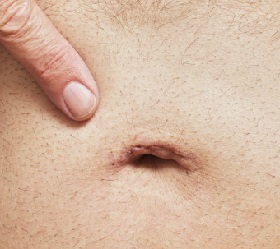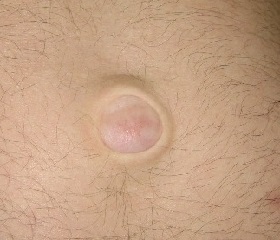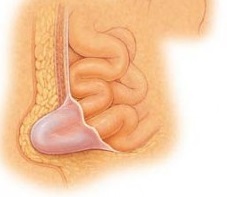 Umbilical hernia is a pathological protrusion of the abdominal cavity through the umbilical ring, which can disappear or significantly decrease in size with the horizontal position of the body.This disease in adults occurs in 6-10% of the population and is more common in women, unlike men.
Umbilical hernia is a pathological protrusion of the abdominal cavity through the umbilical ring, which can disappear or significantly decrease in size with the horizontal position of the body.This disease in adults occurs in 6-10% of the population and is more common in women, unlike men.
First, the umbilical hernia is small, disappears in the supine position, easily refreshed. But eventually the umbilical ring can expand more and more, the hernia grows. Its contents are first the omentum, then the small intestine gets there. But time goes by, but a person is not treated. The navel ring increases as if not much at all. Then time comes, and the hernia does not fit anymore.
Treatment of umbilical hernia in adults is carried out only surgically, regardless of the symptoms. Modern methods of operating a hernia can be divided into two methods - the installation of a reticular implant and suturing the hernial gates. These methods practically do not leave scars on the body and the recovery period after the operation is from 1 to 5 days. After the operation, a patient can be prescribed a diet, limiting physical exertion for a long time.
Causes
Umbilical hernia occurs when the balance between intra-abdominal pressure and the ability of the walls of the abdomen to counteract it is disturbed. In a simple sense, this means that the weak muscles of the abdomen can lead to a hernia if the person lifts the weights and stiffens heavily. In medicine, two categories of factors that lead to a hernia are classified:
- Predisposing. In this category are factors related to the constitution of man - for example, heredity, a certain structure of the body, age, sex. Thus, in pregnant women, the development of a hernia is very likely due to intra-abdominal pressure.
- Generating. This category of factors contributes to increased intra-abdominal pressure. It is because of them as a result of a hernia - for example, when lifting the load, a strong cough, prolonged constipation, etc.
Thus, umbilical hernia in adults is a common phenomenon, the symptoms of the disease have characteristic features, and distinguish it from other types of hernias, as a rule, is not particularly difficult.
Symptoms of umbilical hernia in adults
 Umbilical hernia is always accompanied by visual symptoms, so it's not difficult to notice the beginning of its appearance attentive to one's health.
Umbilical hernia is always accompanied by visual symptoms, so it's not difficult to notice the beginning of its appearance attentive to one's health.
A small spherical protrusion in the navel may not even immediately attract your attention. And meanwhile - this is the first sign of the development of the umbilical hernia in adults. In a state of rest, lying on the back, this swelling disappears, and when coughing, stomach tension - protrudes.
At first, this education is easily set in place. But then begins the adhesion process, and the direction of the hernia into the abdominal cavity becomes impossible. There are characteristic drawing pains when lifting weights or other physical stress associated with the tension of abdominal muscles. Similar symptoms are felt during defecation, especially in case of constipation.
If the hernia in adults reaches a fairly large size, which stops refilling into the abdominal cavity, the symptoms are aggravated: constipation, vomiting, and violation of urination appear. This significantly worsens the patient's quality of life. In the absence of surgical treatment, it is possible to develop dangerous complications-infringement, threats of inflammation, tumor damage, development of coprostasis.
What is necessary for the diagnosis?
Umbilical hernia is a disease treated by a surgeon. Patients who come with characteristic symptoms are first examined by a doctor, the clinical manifestations of the disease are studied. To confirm the diagnosis, a specialist often assigns some additional studies.
The modern informative methods of research include the following:
- X-ray examination of the duodenum and stomach;
- Gastroscopy - esophagogastroduodenoscopy, EGDS;
- Gerniography with the introduction of a contrast medium into the abdominal cavity;
- Ultrasound examination of hernia formation.
Umbilical hernia in its manifestations is similar to the symptoms of some benign subcutaneous tissue tumors (lipomas, dermatomes, dermatofibromas), congenital malformations in the area umbilical ring, very rarely in this area of the abdomen may appear separated metastases of malignant neoplasms of virtually all organs and systems of the human body.
That is why when any protrusion in the region of the umbilical cavity and the umbilical ring appears or somewhat away from it, one should consult a qualified surgeon for advice.
What does the umbilical hernia look like?
Infringement of the umbilical hernia
Umbilical hernia in adults can be impaired. Such manifestations are typical for the elderly, because the conditions for infringement of the hernia manifest themselves with time, and, the longer the hernia, the more likely it is for the infringement to occur.
Infringement of a hernia can occur at any size of formation. The main symptom is a sharp manifestation of pain in the area of the hernial protrusion, as well as the inability to correct the hernia, which previously was simply set in.
If the intestinal loops are infringed, then the symptoms characteristic of the state of acute intestinal obstruction may appear.
Treatment of umbilical hernia
Treatment of the emerging umbilical hernia in adults should be mandatory. If it is not treated in time, there can be serious consequences - infringement.
Conservative therapyis used only in the absence of complications, and also if the patient has contraindications to the operation:
- acute diseases;
- exacerbation of chronic diseases;
- diseases of the cardiovascular system;
- large gestation.
Depending on the stage of development, one of the methodssurgical treatment:
- plastic hernia gates using the patient's own tissues;
- operation with the use of synthetic implants;
- Laparoscopic hernioplasty with the use of synthetic implants (mesh).
How to treat the umbilical hernia in each case will be decided by the surgeon. Today, laparoscopic techniques of hernioplasty are becoming more widespread and more popular. Removing the umbilical hernia during a minimally invasive surgical procedure not only allows to completely eliminate the neoplasm, but also has a number of advantages, for example, a short period of rehabilitation, a low probability of complications.
Stretching hernioplasty
Hernia graft surgery is recommended for small umbilical hernias, up to 5 centimeters in size. The operation is fast, often under local anesthesia. During surgical intervention, the surgeon restores the anatomical ratio of tissues, strengthens the weak points of the abdominal wall. Complications are rare for this type of treatment.
The main disadvantages of this methodtreatment is as follows:
- Long period of rehabilitation. After this type of operation, rehabilitation can last up to a year. It is recommended to limit physical activity, exercise.
- Frequent relapses. Occurrence of repeated umbilical hernia in the same place. According to some data, the frequency of such complications in the treatment of small hernias is 5 to 20%. And in the treatment of umbilical hernias of large sizes and completely up to 30-50%.
- Presence of a postoperative scar. Also, when using the operation using the Sapezhko method, the hernia is removed along with the navel. This leads to a significant cosmetic defect.
Non-tension hernioplasty
Treatment of a hernia using implants - woven mesh - is also called non-stretch plastic. The method is optimal for large hernias. The endoprosthesis strengthens the hernial gates. The operation gives a very good result: when following the recommendations of a doctor, relapses are virtually eliminated. To restore the patient requires a minimum of time.
Advantages of the methodologythe following:
- Short rehabilitation period. With this technique, it is from seven to twenty days. On the first day after the operation, the patient can get out of bed and eat. On the third day you can observe the usual diet.
- Absence of a cosmetic defect in the form of a postoperative scar.
- Low frequency of relapses. According to some data, it is up to 1%.
- Absence of prolonged pain syndrome in the postoperative period.
- Low traumatic surgery, the possibility of its conduct with concomitant somatic diseases.
Laparoscopic hernioplasty
In laparoscopic surgery, a reticular implant is also used, it is inserted through a puncture in the abdominal wall.
The surgeon does not make a large incision, which significantly shortens the period of postoperative rehabilitation. According to reviews, this surgery is most preferable for adult patients.
But there are certain difficulties. For carrying out laparoscopic hernioplasty, special equipment and trained surgeons are needed. This opportunity is not at any hospital. Operations through the puncture are contraindicated in patients with the pathology of the respiratory and cardiovascular system, with a large expansion of the umbilical ring.
Rehabilitation after surgery
Usually, if the operation passes without complications, the patient is allowed to get up on the first day.
- In the postoperative period, a special bandage is shown (when using reticular implants - about a month).
- On the 10-14th day, you can begin to practice therapeutic gymnastics, but it is forbidden to perform exercises for the abdominal press.
- After the operation, daily dressings are performed, the sutures are removed on day 7 (if they do not resolve themselves).
- Pain is prescribed painkillers.
- Also, a doctor can prescribe antibiotics, vitamins, immunomodulators.
After surgery, patients should avoid physical exertion and any actions that provoke muscle tension in the abdominal wall.
Umbilical hernia in adults: reviews after surgery
 We picked up some reviews of adult patients who underwent an operation to remove the inguinal hernia.
We picked up some reviews of adult patients who underwent an operation to remove the inguinal hernia.
- It's been 3 years since I underwent a hernia repair operation. Everything was fine, until I was scared and screamed sharply - from a sudden strain of hernia appeared again. We performed the operation with the help of tension hernioplasty, now I will insist on installing the net. The doctor was very wise, he told everything and showed, assured that everything would be fine.
- I was rushed very quickly, but under general anesthesia. As soon as I left the anesthesia, immediately went to walk around the hospital, I think everyone else will be the same. The doctor wrote out in 6 days, allowed everything, except lifting weights and physical education - about jogging had to be forgotten for a while ...
- And my hernia was operated on 4 months ago. In the hospital, only 2 weeks were kept (1 week made the necessary tests, then the operation was performed, and the rest of the time I was restored). A day after the operation, she could walk by herself, it was not particularly painful. The doctor allowed to raise no more than 4-6 kg, and so you need to do another 6 months.
Treatment without surgery
Sometimes operations are contraindicated to people for a number of reasons. In this case, doctors recommend that adults wear a bandage from the umbilical hernia. It helps to keep abdominal tissue, and the likelihood that the build-up will not become larger decreases.
You can also massage the abdominal area. The aim of the procedure is to increase muscle tone. Recommended:
- stroking the abdomen (clockwise);
- light tingling near the umbilical region;
- rubbing the muscles of the abdominal press;
- easy relaxing stroking.
The physical load should be moderate - overloading can lead to a worsening of the patient's condition.

How to choose probiotics for the intestine: a list of drugs.

Effective and inexpensive cough syrups for children and adults.

Modern non-steroidal anti-inflammatory drugs.

Review of tablets from the increased pressure of the new generation.
 Antiviral drugs are inexpensive and effective.
Antiviral drugs are inexpensive and effective.


